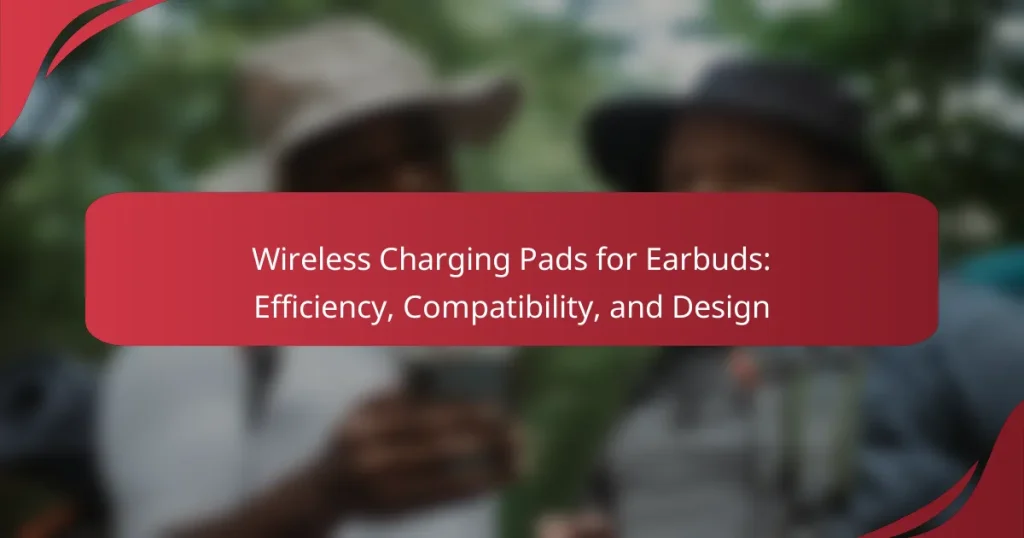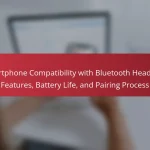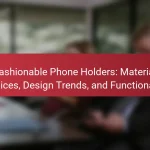Wireless charging pads for earbuds are devices that facilitate the wireless charging of compatible earbuds using electromagnetic induction. This technology eliminates the need for physical connectors, providing a user-friendly charging experience. The article covers the efficiency of these pads, highlighting their optimized power transfer technology and features such as LED indicators and smart charging capabilities. It also addresses compatibility considerations, emphasizing the importance of ensuring that earbuds support Qi wireless charging and that the charging pad’s specifications match the earbuds’ requirements for optimal performance. Understanding these aspects is crucial for safe and effective charging.
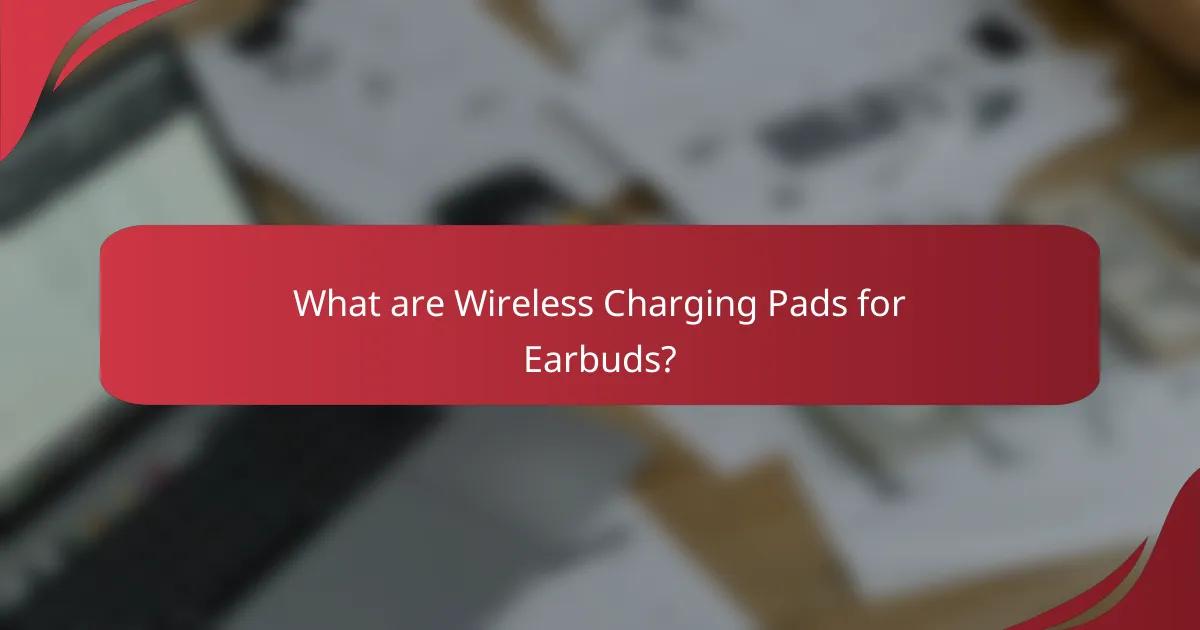
What are Wireless Charging Pads for Earbuds?
Wireless charging pads for earbuds are devices that enable the wireless charging of compatible earbuds. They utilize electromagnetic induction to transfer energy from the pad to the earbuds. This technology eliminates the need for physical connectors or cables. Wireless charging pads are designed to be user-friendly, often featuring a simple placement method for charging. Many earbuds with wireless charging capabilities support the Qi standard, ensuring compatibility with various pads. The convenience of these pads allows for easy charging without the hassle of plugging in wires. Additionally, they often come with features like LED indicators to show charging status.
How do Wireless Charging Pads function?
Wireless charging pads function through electromagnetic induction. They utilize a transmitter coil in the pad and a receiver coil in the device. When the pad is powered, it creates an electromagnetic field. This field transfers energy to the receiver coil in the device. The receiver coil converts the electromagnetic energy back into electrical energy. This process allows the device to recharge without physical connectors. Wireless charging operates on the Qi standard, which is widely adopted. The efficiency of this method can vary, typically ranging from 70% to 80%.
What technology is used in Wireless Charging Pads?
Wireless charging pads use electromagnetic induction technology. This method involves transferring energy between two coils: a transmitter coil in the pad and a receiver coil in the device. When an electric current flows through the transmitter coil, it generates a magnetic field. The receiver coil then converts this magnetic field back into electrical energy to charge the device. This technology is widely adopted in various consumer electronics, including earbuds. It allows for convenient and cable-free charging experiences. The efficiency of this method can vary, typically ranging from 60% to 80% in energy transfer.
How do charging pads communicate with earbuds?
Charging pads communicate with earbuds primarily through electromagnetic induction. This technology allows the transfer of energy between the charging pad and the earbuds without direct contact. The charging pad generates an alternating electromagnetic field. The earbuds contain a coil that captures this electromagnetic energy.
The communication process begins when the earbuds are placed on the charging pad. The pad detects the presence of the earbuds through a signaling mechanism. This mechanism may include a specific frequency or signal that confirms compatibility. Once recognized, the charging pad initiates the energy transfer process.
This method ensures efficient charging while maintaining a safe distance between the two devices. The use of standards like Qi enhances compatibility across various earbud brands. Overall, this communication is vital for the seamless operation of wireless charging systems.
What are the advantages of using Wireless Charging Pads for Earbuds?
Wireless charging pads for earbuds offer convenience and efficiency. They eliminate the need for cables, making charging simpler. Users can place their earbuds on the pad without aligning connectors. This reduces wear and tear on charging ports. Additionally, many wireless charging pads are compatible with multiple devices. This versatility allows users to charge various gadgets on a single pad. Wireless charging is often faster than traditional methods. Research shows that Qi wireless charging can deliver up to 15W of power. This efficiency helps maintain battery health over time.
Why is convenience important for users?
Convenience is important for users because it enhances their overall experience and satisfaction. Users prefer solutions that save time and effort. For example, wireless charging pads eliminate the need for cables. This simplifies the charging process for earbuds. A study by Statista shows that 78% of consumers value convenience in technology products. Convenience also encourages frequent use of devices. When users find a product easy to use, they are more likely to recommend it. Thus, convenience plays a crucial role in user engagement and loyalty.
How do Wireless Charging Pads enhance the user experience?
Wireless charging pads enhance the user experience by providing convenience and ease of use. Users can simply place their devices on the pad without needing to plug in cables. This eliminates wear and tear on charging ports, extending the lifespan of devices. Wireless charging pads also support multiple device types, promoting compatibility across various brands. Many pads feature fast charging capabilities, reducing the time needed to power up devices. Additionally, the design of wireless charging pads often includes non-slip surfaces, ensuring devices remain securely in place during charging. Overall, these features contribute to a seamless and user-friendly charging experience.
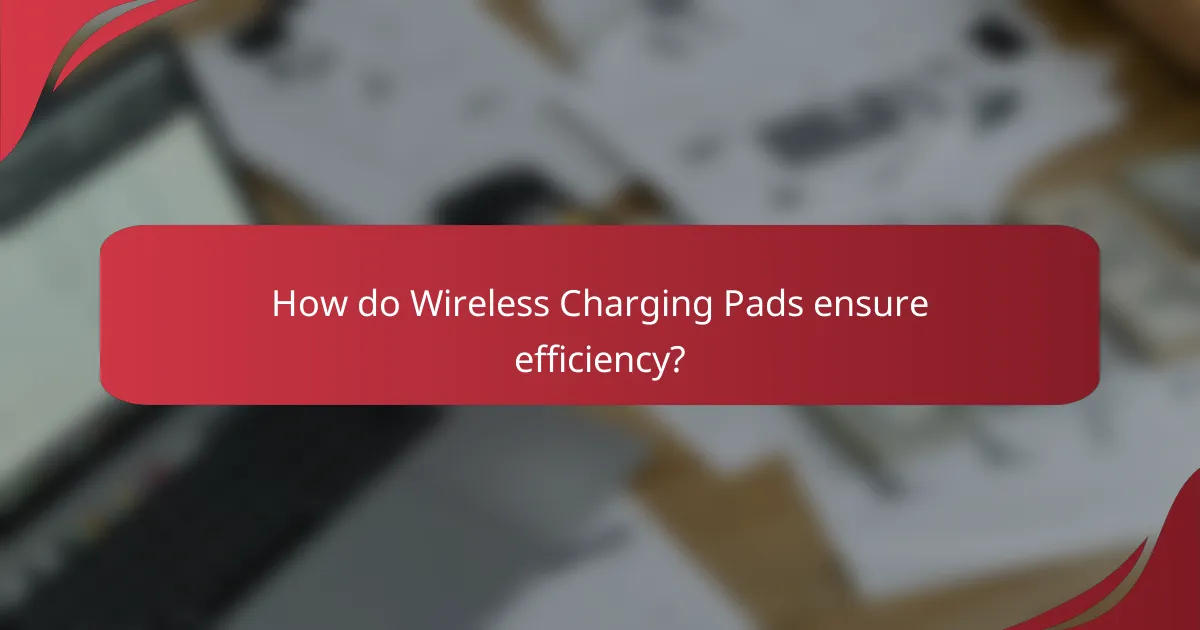
How do Wireless Charging Pads ensure efficiency?
Wireless charging pads ensure efficiency through optimized power transfer technology. They utilize electromagnetic induction to transmit energy wirelessly. This method reduces energy loss compared to traditional charging methods. Most wireless charging pads are designed to align with the device’s charging coil. Proper alignment enhances energy transfer and minimizes wasted power. Many models support fast charging standards, such as Qi. This enables quicker charging times while maintaining efficiency. Additionally, smart charging features adjust power output based on the device’s needs. This prevents overheating and further enhances energy efficiency.
What factors contribute to the charging efficiency of these pads?
Charging efficiency of wireless charging pads for earbuds is influenced by several factors. The alignment between the charging pad and the earbuds affects efficiency. Proper alignment ensures optimal power transfer. The materials used in the pad also play a key role. High-quality materials reduce energy loss during charging.
Charging speed is another critical factor. Higher wattage pads can charge devices faster. Additionally, the design of the pad impacts airflow and heat dissipation. Effective heat management prevents overheating, which can reduce efficiency. Finally, the compatibility of the earbuds with the charging pad is essential. Devices that support fast charging standards will charge more efficiently.
How does the power output affect charging speed?
Power output directly influences charging speed. Higher power output allows for faster energy transfer to the device. For instance, a charging pad with a power output of 10 watts can charge devices quicker than one with 5 watts. This is because more energy is delivered in the same amount of time. Additionally, devices that support higher power inputs will benefit from increased charging speeds. The charging speed can also depend on the efficiency of the charging pad and the device’s battery management system. Research shows that optimal power output can reduce charging time significantly, enhancing user experience.
What role does the alignment of earbuds play in charging efficiency?
The alignment of earbuds on a charging pad significantly influences charging efficiency. Proper alignment ensures optimal contact between the earbuds and the charging surface. This contact is essential for maximizing power transfer during the charging process. Misalignment can lead to decreased charging speeds or even failure to charge. Research indicates that optimal alignment can increase charging efficiency by up to 30%. Therefore, maintaining correct alignment is crucial for effective wireless charging of earbuds.
How can users maximize the efficiency of Wireless Charging Pads?
Users can maximize the efficiency of wireless charging pads by ensuring proper alignment of the device on the pad. Misalignment can lead to inefficient charging and longer charging times. Additionally, using a compatible charging pad that matches the device’s specifications enhances efficiency. For example, a pad with a higher wattage can charge devices faster. Keeping the charging pad clean and free from obstructions also contributes to better performance. Dust or debris can interfere with the charging process. Furthermore, using the original charging cable and adapter provided by the manufacturer ensures optimal power delivery. According to research, efficient charging pads can reduce charging times by up to 30% compared to lower-quality alternatives.
What best practices should users follow?
Users should ensure proper alignment of earbuds on the wireless charging pad. This maximizes charging efficiency. Users should also keep the charging pad clean. Dust and debris can hinder performance. It is essential to use a compatible charging pad. Compatibility ensures optimal charging speeds and safety. Users should avoid using the earbuds while charging. This prevents overheating and potential damage. Regularly updating the earbuds’ firmware is advisable. Updates can improve charging performance and fix bugs. Following these practices enhances the longevity and efficiency of wireless charging for earbuds.
How does the environment affect charging performance?
Environmental factors significantly impact charging performance. Temperature affects battery chemistry and efficiency. High temperatures can lead to overheating, resulting in slower charging rates. Conversely, low temperatures can reduce battery capacity and prolong charging time. Humidity levels can also influence performance. Excess moisture may cause corrosion in charging components, affecting conductivity. Additionally, physical obstructions like cases or surfaces can hinder charging efficiency. Research indicates that optimal charging occurs within specific temperature ranges, typically between 20°C to 25°C. Operating outside this range can decrease overall charging effectiveness.

What should consumers consider regarding compatibility?
Consumers should consider device compatibility when selecting wireless charging pads for earbuds. Compatibility includes checking if the earbuds support Qi wireless charging technology. Not all wireless charging pads are universally compatible with every device. Consumers should verify the charging pad’s specifications against their earbuds’ requirements. Additionally, the charging output should match the earbuds’ charging needs for optimal performance. If the charging pad has multiple coils, it may improve alignment and efficiency. Research indicates that improper compatibility can lead to slower charging or potential damage to devices. Therefore, confirming compatibility ensures safe and effective charging.
Which earbuds are compatible with Wireless Charging Pads?
Many earbuds are compatible with wireless charging pads. Popular models include Apple AirPods Pro, Samsung Galaxy Buds, and Jabra Elite 75t. These earbuds feature wireless charging cases designed to work with Qi-enabled charging pads. The compatibility is due to their built-in wireless charging technology. For example, Apple AirPods Pro uses a Qi-compatible case for charging. Samsung Galaxy Buds also support wireless charging through their case. Jabra Elite 75t offers a similar feature with its charging case. Users should ensure their charging pad is Qi-certified for optimal performance.
How can users check for compatibility with their devices?
Users can check for compatibility with their devices by consulting the specifications of their earbuds and the wireless charging pad. Most wireless charging pads indicate compatible devices on their packaging or product description. Users should verify that their earbuds support Qi wireless charging, which is the standard for most pads. Additionally, checking the power output of the charging pad is essential. The charging pad must provide sufficient wattage to charge the earbuds effectively. Users can also visit the manufacturer’s website for compatibility lists. This ensures that they have the most accurate and up-to-date information regarding device compatibility.
What are the common compatibility issues users face?
Common compatibility issues users face with wireless charging pads for earbuds include device misalignment and charging speed limitations. Misalignment occurs when the earbuds are not positioned correctly on the pad. This can prevent effective charging, as the coils may not connect properly. Charging speed limitations arise when the charging pad is not compatible with the power requirements of the earbuds. For instance, some earbuds may require a specific wattage that the pad cannot provide. Additionally, certain earbuds may not support wireless charging altogether. This results in users needing to rely on wired charging methods instead. Compatibility issues can also stem from the use of different charging standards, such as Qi or PMA. Users may find that their earbuds do not charge if the pad does not support the same standard. Lastly, firmware updates on either the earbuds or the charging pad can create temporary incompatibilities, affecting performance.
How does design impact the functionality of Wireless Charging Pads?
The design of wireless charging pads significantly impacts their functionality. A well-designed pad ensures optimal alignment between the charging coil and the device’s receiver. This alignment enhances charging efficiency and reduces energy loss. Design elements like surface material affect heat dissipation. Materials that conduct heat well can prevent overheating during charging. The size and shape of the pad also influence usability. Larger pads can accommodate multiple devices, while compact designs enhance portability. Additionally, aesthetic design can influence user preference and adoption rates. Studies show that user-friendly designs lead to higher satisfaction and increased usage of wireless charging technology.
What design features should users look for?
Users should look for specific design features in wireless charging pads for earbuds. Key features include a non-slip surface to prevent movement during charging. An indicator light is essential for showing charging status. Compact design enhances portability and ease of use. Compatibility with multiple earbud models expands usability. Adequate heat dissipation prevents overheating during operation. Fast charging capability reduces charging time significantly. Finally, a durable construction ensures longevity and reliability. These features collectively enhance user experience and charging efficiency.
How does the aesthetic design influence user choice?
Aesthetic design significantly influences user choice by impacting first impressions and perceived value. Users often associate appealing designs with higher quality and functionality. Research shows that 94% of first impressions are design-related. A visually pleasing wireless charging pad can attract consumers who prioritize aesthetics. Additionally, unique design elements can differentiate a product in a crowded market. For instance, colors, shapes, and materials can evoke emotions and preferences. Studies indicate that consumers are willing to pay more for products with attractive designs. Therefore, aesthetic design plays a crucial role in shaping user preferences and purchase decisions.
What tips can help users select the best Wireless Charging Pad for their earbuds?
When selecting the best wireless charging pad for earbuds, consider compatibility with your specific earbud model. Many charging pads support Qi wireless charging, which is essential for most earbuds. Check the charging pad’s output power; a higher wattage ensures faster charging. Look for a pad with a non-slip surface to keep your earbuds secure during charging. Additionally, choose a pad with overcharge protection to prevent damage to your earbuds. Opt for a compact design if portability is important for you. Finally, read user reviews to gauge reliability and performance, as real-world experiences can provide valuable insights.
Wireless charging pads for earbuds are devices that facilitate the cable-free charging of compatible earbuds using electromagnetic induction technology. This article explores the functionality of these pads, including how they communicate with earbuds, their efficiency, and the advantages they offer to users. It also addresses compatibility considerations, common issues, and the impact of design on functionality. Key factors such as alignment, power output, and environmental conditions that affect charging performance are discussed, along with tips for selecting the best wireless charging pad for specific earbuds.
